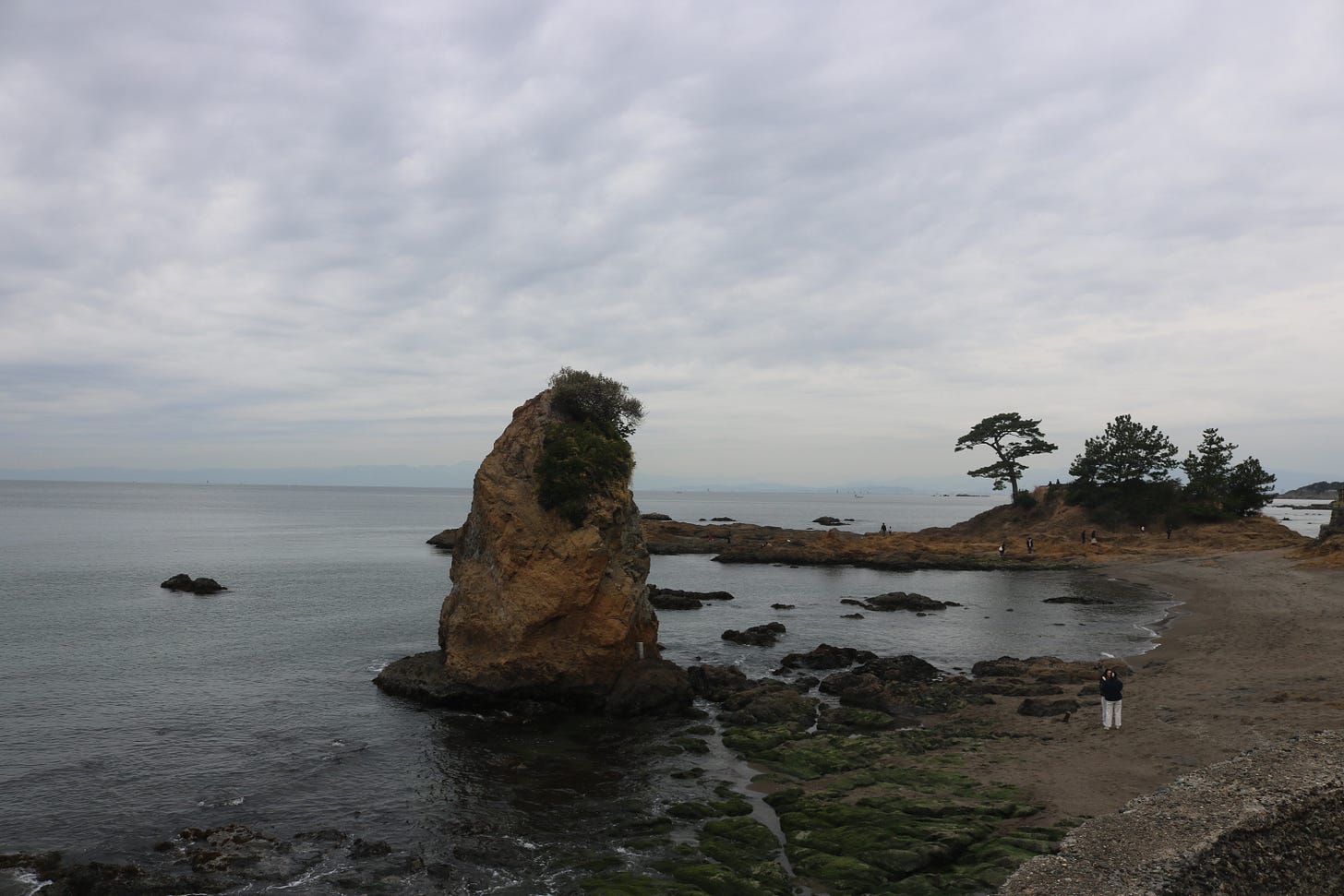#83 and #84 Saturday, March 15, 2025: Sarushima and Tateishi Kouen, Kanagawa
I knew I was getting near to Yokosuka when I saw a western fellow strolling down the street in shorts on this chilly day. He had very short hair, two large leg tattoos and the girth on each leg was equivalent a small tree trunk. He was almost as wide as he was tall and his t-shirt looked painted onto his chest which pushed his muscular arms out widely as he walked. He looked like a cartoon and I had no doubt he had come from Yokosuka’s American military base.
I hadn’t come here because of the base, though; I was here to visit the only non-artificial island in Tokyo Bay; Sarushima.
Sarushima means Monkey Island but it is not home to any monkeys. It gained its name due to an old legend that says when the Buddhist monk Nichiren was having a spot of bother on the stormy seas in 1253 and got shipwrecked here, he prayed in a cave to be rescued and a pure white monkey appeared and guided him to safety on the island. Incidentally, when Commodore Matthew Perry rolled up here in 1853 he tried to get everyone to call it Perry Island, but it seems he was largely ignored.
What Sarushima is mostly known for is its role as a fortress with gun batteries and ammunition depots, and it is these that most visitors come to see today. It became heavily fortified during the Tokugawa Shogunate (1603-1867) and remained so up until World War II. What remains are old red brick tunnels, remnants of barracks, and gun emplacements, mostly dating from the Meiji Era (1868-1912). In 1945 the island came under American control, finally being returned in 1961, and now functions primarily as a tourist destination.
The island is clearly visible from the coast and is just a short ferry ride away. You leave from Mikasa Ferry Terminal and the return trip and entry to the island cost ¥2,000.
As we approached the island I noticed the rockface was crowded with cormorants. Down below, by the water’s edge a heron waited patiently for a chance to snaffle some fish.
As soon as we disembarked, several guides were waiting offering to take us on thirty-minute tour of the island. I decided to just go at my own pace, but thirty minutes is really about all that’s needed.
The island is largely overgrown and mossy, but no less attractive for that. A couple of signs warned of the dangers of Asian hornets and caterpillars.
I sauntered past the old abandoned power station, through the brick tunnels and by the gun batteries and watchtowers. At a crossroads a sign pointed towards Nichiren’s Cave. I followed the path to its conclusion where I found another sign pointing towards Nichiren’s Cave, but beyond a chain prohibiting access. The cave remained out of sight. I followed another path down some steps to opposite side of the island from the ferry terminal and arrived at a pleasing rocky coast where a child and his father were looking into rock pools.
It wasn’t long until I was back near the ferry terminal. There is a small beach here where barbecues are popular in summer. Online, the beach was described as beautiful but on this cloudy day, that would be a bit of an exaggeration.
I was early for my return ferry so sat and enjoyed a coffee at one of several picnic tables with a little bird that came to join me. Our peace was soon disturbed by a group of young adults excitedly chattering while dressed as anime characters.
I hadn’t spent as long as I had expected on Sarushima and decided I had time to visit another place on my day out. Just a twenty-minute drive away from the Mikasa Ferry Terminal, along the coast in Tateishi Kouen, a scenic coastal park popular with artists and photographers and was famously depicted in ukiyo-e by Hiroshige. I wandered along the beach passing the tall standing rock from which the park takes its name and over the rocks jumping over small channels where the se water rushed in. I could understand why it was listed as one of the 50 scenic spots in Kanagawa. On clearer days Mount Fuji can be seen from here, but I rather liked it on this gloomy grey day. It gave it an atmosphere of brooding elegance

Current tally: 84 / 2,338
Prefectures: 8 / 47
















